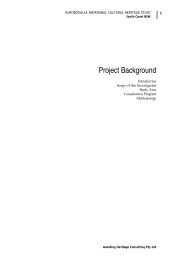Eurobodalla Integrated Water Cycle Management Strategy
Eurobodalla Integrated Water Cycle Management Strategy
Eurobodalla Integrated Water Cycle Management Strategy
You also want an ePaper? Increase the reach of your titles
YUMPU automatically turns print PDFs into web optimized ePapers that Google loves.
<strong>Eurobodalla</strong> <strong>Integrated</strong> <strong>Water</strong> <strong>Cycle</strong> <strong>Management</strong> <strong>Strategy</strong><br />
the town at this time, as additional water consumption will increase the on-site septic<br />
systems loads.<br />
Rainwater tanks can be less reliable than town water supplies and if gutters, roof surfaces<br />
and tanks are not well maintained it may result in poor quality water. A full reticulated town<br />
water supply would significantly reduce public health risks through ensuring that the water<br />
supply meets the Australian Drinking <strong>Water</strong> Quality Guidelines. This option would also<br />
eliminate the need for houses to import water during low rainfall and drought periods<br />
In this case the average annual and peak reticulated water demands for the full<br />
development situation would be about 20 ML/a and 0.14 ML/d respectively.<br />
The scheme facilities necessary to provide a full reticulated water supply to Congo would be<br />
similar to those required for a supplemented reticulated supply as discussed previously.<br />
The facility and component sizes would however be required to be slightly larger. The<br />
provision of larger pipes and facilities would enable the provision of fire fighting services at<br />
minimal extra cost.<br />
Improved <strong>Management</strong> of Existing On-site Wastewater Facilities<br />
Sewage is currently treated by on-site systems. The seepage from existing on-site<br />
wastewater management systems could be reduced by regularly emptying the contents of<br />
the septic tanks and installing monitoring systems to prevent septic tank overflows and to<br />
assess the integrity of the tanks. Regular pumpouts and monitoring has the potential to<br />
minimise many of the environmental and public health impacts associated with the<br />
operation of septic systems.<br />
A single contract could be arranged by the Council or by the community such that the septic<br />
tanks are pumped at set time intervals. This would cover both effluent and sullage<br />
pumpout. The cost of this pumpout could be evenly split among the residents. To facilitate<br />
pumping every tank would require a smaller holding tank or pumpout facility.<br />
Although this opportunity would reduce the potential for waterway and aquifer<br />
contamination, it may but result in additional community impacts, such as odours<br />
associated with pumpouts and the movement of trucks in the neighbourhood.<br />
A risk analysis undertaken for most of the villages of <strong>Eurobodalla</strong> indicated that Congo has<br />
the least environmental and social risk associated with their current management practices.<br />
Nevertheless, if Council adopts management solutions for the other small villages, there<br />
may be economies of scale in considering the inclusion of Congo in a Shire-wide septic<br />
management scheme.<br />
Enhanced <strong>Management</strong> of Existing On-site Wastewater Facilities<br />
There are several options available to upgrade the existing on-site wastewater<br />
management systems to achieve greater public health and environmental outcomes. The<br />
first option is to retain the existing septic tank and upgrade the on-site effluent management<br />
system. An example of this would be the replacement of the adsorption trenches with lined<br />
evapotranspiration beds, which achieve a higher level of water and nutrient uptake through<br />
plants.<br />
Another alternative is to upgrade the septic system to one that achieves nutrient removal<br />
and therefore results in a higher quality effluent discharge (e.g. aerated tanks). This would<br />
increase the potential uses available to the treated effluent.<br />
Both these options would minimise the potential for groundwater contamination, and its<br />
associated environmental problems as well as reducing the likelihood of public health<br />
issues and odour complaints.<br />
169

















